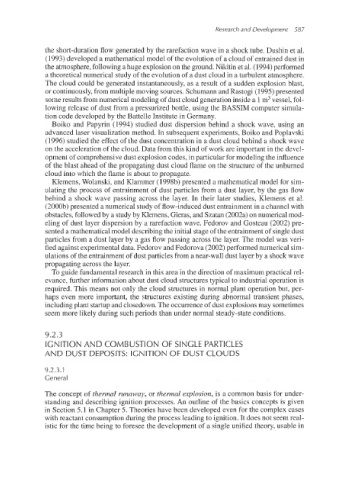Page 620 - Dust Explosions in the Process Industries
P. 620
Research and Development 587
the short-duration flow generated by the rarefaction wave in a shock tube. Dushin et al.
(1993) developed a mathematical model of the evolution of a cloud of entrained dust in
the atmosphere, following a huge explosion on the ground. Nikitin et al. (1994) performed
a theoretical numerical study of the evolution of a dust cloud in a turbulent atmosphere.
The cloud could be generated instantaneously, as a result of a sudden explosion blast,
or continuously, from multiple moving sources. Schumann and Rastogi (1995) presented
some results from numerical modeling of dust cloud generation inside a 1m3vessel, fol-
lowing release of dust from a pressurized bottle, using the BASSIM computer simula-
tion code developed by the Battelle Institute in Germany.
Boiko and Papyrin (1994) studied dust dispersion behind a shock wave, using an
advanced laser visualization method. In subsequent experiments, Boiko and Poplavski
(1996) studied the effect of the dust concentration in a dust cloud behind a shock wave
on the acceleration of the cloud. Data from this kind of work are important in the devel-
opment of comprehensive dust explosion codes, in particular for modeling the influence
of the blast ahead of the propagating dust cloud flame on the structure of the unburned
cloud into which the flame is about to propagate.
Klemens, Wolanski, and Klammer (199%) presented a mathematical model for sim-
ulating the process of entrainment of dust particles from a dust layer, by the gas flow
behind a shock wave passing across the layer. In their later studies, Klemens et al.
(2000b) presented a numerical study of flow-induced dust entrainment in a channel with
obstacles, followed by a study by Klemens, Gieras, and Szatan (2002a) on numerical mod-
eling of dust layer dispersion by a rarefaction wave. Fedorov and Gosteau (2002) pre-
sented a mathematical model describing the initial stage of the entrainment of single dust
particles from a dust layer by a gas flow passing across the layer. The model was veri-
fied against experimental data. Fedorov and Fedorova (2002) performed numerical sim-
ulations of the entrainment of dust particles from a near-wall dust layer by a shock wave
propagating across the layer.
TOguide fundamental research in this area in the direction of maximum practical rel-
evance, further information about dust cloud structures typical to industrial operation is
required. This means not only the cloud structures in normal plant operation but, per-
haps even more important, the structures existing during abnormal transient phases,
including plant startup and closedown. The occurrence of dust explosions may sometimes
seem more likely during such periods than under normal steady-state conditions.
9.2.3
IGNlTllON AND COMBUSTION OF SINGLE PARTICLES
AND DUST DEPOSITS: IGNITION OF DUST CLOUDS
9.2.3.1
General
The concept of thermal runaway, or thermal explosion, is a common basis for under-
standing and describing ignition processes. An outline of the basics concepts is given
in Section 5.1 in Chapter 5. Theories have been developed even for the complex cases
with reactant consumption during the process leading to ignition. It does not seem real-
istic for the time being to foresee the development of a single unified theory, usable in

